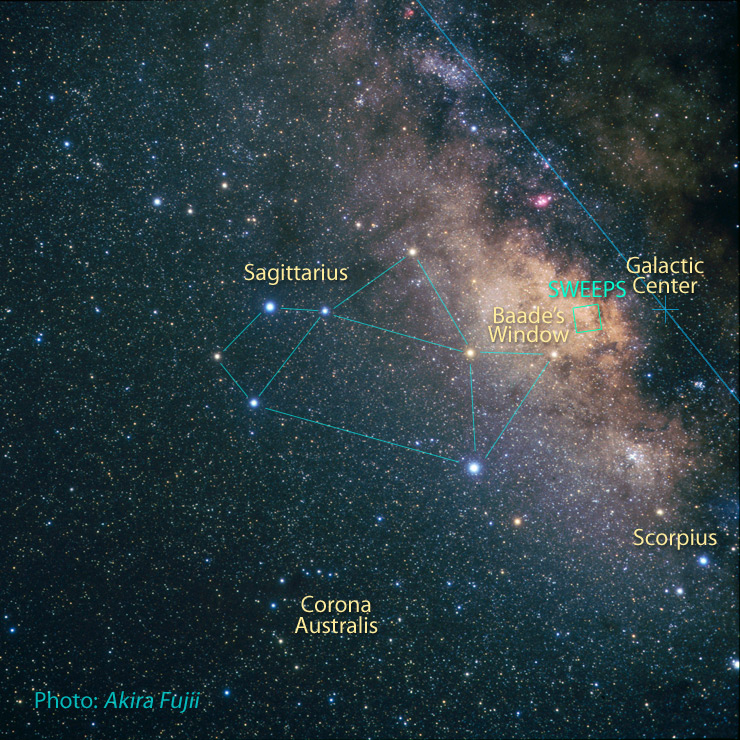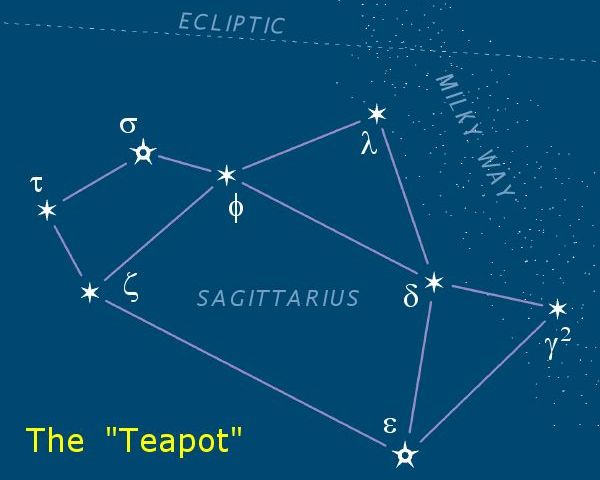|
SWEEPS-10
, - style="vertical-align: top;" SWEEPS-10 is an extrasolar planet that, from June 2007 to August 2011, was the planet candidate with the shortest orbital period yet found, until PSR J1719-1438 b was discovered in 2011 with an even shorter orbit. The planet orbits the star SWEEPS J175902.00−291323.7 located in the Galactic bulge at a distance of approximately 22,000 light years from Earth (based on a distance modulus of 14.1). It completes an orbit of its star (designated SWEEPS J175902.00−291323.7) in just 10 hours, and is categorized as an ultra-short period planet (USPP). Located only 1.2 million kilometers from its star (roughly three times the distance between the Earth and the Moon), the planet is among the hottest ever detected; its estimated temperature is approximately 1,650 degrees Celsius. "This star-hugging planet must be at least 1.6 times the mass of Jupiter, otherwise the star's gravitational muscle would pull the planet apart," said team leader K ... [...More Info...] [...Related Items...] OR: [Wikipedia] [Google] [Baidu] |
Sagittarius Window Eclipsing Extrasolar Planet Search
The Sagittarius Window Eclipsing Extrasolar Planet Search, or SWEEPS, was a 2006 astronomical survey project using the Hubble Space Telescope's Advanced Camera for Surveys - Wide Field Channel to monitor 180,000 stars for seven days to detect extrasolar planets via the transit method. Area examined The stars that were monitored in this astronomical survey were all located in the Sagittarius-I Window. The Sagittarius Window is a rare view to the Milky Way's central bulge stars: our view to most of the galaxy's central stars is generally blocked by lanes of dust. These stars in the galaxy's central bulge region are approximately 27,000 light years from Earth. Planets discovered Sixteen candidate planets were discovered with orbital periods ranging from 0.6 to 4.2 days. Planets with orbital periods less than 1.2 days have not previously been detected, and have been dubbed "ultra-short period planets" (USPPs) by the search team. USPPs were discovered only around low-mass stars ... [...More Info...] [...Related Items...] OR: [Wikipedia] [Google] [Baidu] |
SWEEPS-04
SWEEPS-04 is an extrasolar planet orbiting the star SWEEPS J175853.92−291120.6 in the constellation Sagittarius approximately 27,710 light years away (based on a distance modulus of 14.1) from the Solar System, making it (along with SWEEPS-11) the most distant exoplanet(s) known. This planet was found in 2006 by the Sagittarius Window Eclipsing Extrasolar Planet Search (SWEEPS) program that uses the transit method. The upper limit on the planet's mass is 3.8 times the mass of Jupiter. The best fit radius is 0.81 times that of Jupiter, but the uncertainty in this value is large, around 12%. It orbits at an average distance of 8,200,000 km (0.055 AU) from the parent star, taking 4.2 days to revolve around it. fILE:HST SWEEPS-4 2006.jpg, HST SWEEPS-4 2006 File:Radial Velocities of SWEEPS-04 (UVES-VLT).jpg, Radial Velocities of SWEEPS-04 (UVES-VLT) File:Artist's impression of a transiting Jupiter-mass exoplanet SWEEPS J175853.92-291120.6 b.jpg, Artist's impression of a tr ... [...More Info...] [...Related Items...] OR: [Wikipedia] [Google] [Baidu] |
SWEEPS-11
SWEEPS-11 is an extrasolar planet orbiting the star SWEEPS J175902.67−291153.5 in the constellation Sagittarius, approximately 27,710 light years away from the Solar System (based on a distance modulus of 14.1), making it (along with SWEEPS-04) the most distant exoplanet(s) known. This planet was found in 2006 by the Sagittarius Window Eclipsing Extrasolar Planet Search (SWEEPS) program that uses the transit method. This hot Jupiter has a mass 9.7 times that of Jupiter and a radius of 1.13 times that of Jupiter. The planet orbits at about 1.75 times closer to the star than 51 Pegasi b is to 51 Pegasi 51 Pegasi (abbreviated 51 Peg), formally named Helvetios , is a Sun-like star located from Earth in the constellation of Pegasus. It was the first main-sequence star found to have an exoplanet (designated 51 Pegasi b, officially named ..., taking only 1.8 days or 43 hours to orbit the star. See also * SWEEPS-04 * SWEEPS-10 References External links * ''Th ... [...More Info...] [...Related Items...] OR: [Wikipedia] [Google] [Baidu] |
Sagittarius (constellation)
Sagittarius is one of the constellations of the zodiac and is located in the Southern celestial hemisphere. It is one of the 48 constellations listed by the 2nd-century astronomer Ptolemy and remains one of the 88 modern constellations. Its old astronomical symbol is (♐︎). Its name is Latin for " archer". Sagittarius is commonly represented as a centaur pulling back a bow. It lies between Scorpius and Ophiuchus to the west and Capricornus and Microscopium to the east. The center of the Milky Way lies in the westernmost part of Sagittarius (see Sagittarius A). Visualizations As seen from the northern hemisphere, the constellation's brighter stars form an easily recognizable asterism known as "the Teapot". The stars δ Sgr (Kaus Media), ε Sgr (Kaus Australis), ζ Sgr (Ascella), and φ Sgr form the body of the pot; λ Sgr (Kaus Borealis) is the point of the lid; γ2 Sgr (Alnasl) is the tip of the spout; and σ Sgr (Nunki) and τ Sgr the handle. These s ... [...More Info...] [...Related Items...] OR: [Wikipedia] [Google] [Baidu] |
Jupiter
Jupiter is the fifth planet from the Sun and the largest in the Solar System. It is a gas giant with a mass more than two and a half times that of all the other planets in the Solar System combined, but slightly less than one-thousandth the mass of the Sun. Jupiter is the third brightest natural object in the Earth's night sky after the Moon and Venus, and it has been observed since prehistoric times. It was named after the Roman god Jupiter, the king of the gods. Jupiter is primarily composed of hydrogen, but helium constitutes one-quarter of its mass and one-tenth of its volume. It probably has a rocky core of heavier elements, but, like the other giant planets in the Solar System, it lacks a well-defined solid surface. The ongoing contraction of Jupiter's interior generates more heat than it receives from the Sun. Because of its rapid rotation, the planet's shape is an oblate spheroid: it has a slight but noticeable bulge around the equator. The outer atmospher ... [...More Info...] [...Related Items...] OR: [Wikipedia] [Google] [Baidu] |
Giant Planets
The giant planets constitute a diverse type of planet much larger than Earth. They are usually primarily composed of low-boiling-point materials (volatiles), rather than rock or other solid matter, but massive solid planets can also exist. There are four known giant planets in the Solar System: Jupiter, Saturn, Uranus and Neptune. Many extrasolar giant planets have been identified orbiting other stars. They are also sometimes called jovian planets, after Jupiter ("Jove" being another name for the Roman god "Jupiter"). They are also sometimes known as gas giants. However, many astronomers now apply the latter term only to Jupiter and Saturn, classifying Uranus and Neptune, which have different compositions, as ice giants. Both names are potentially misleading: all of the giant planets consist primarily of fluids above their critical points, where distinct gas and liquid phases do not exist. The principal components are hydrogen and helium in the case of Jupiter and Saturn, a ... [...More Info...] [...Related Items...] OR: [Wikipedia] [Google] [Baidu] |
Hot Jupiters
Hot Jupiters (sometimes called hot Saturns) are a class of gas giant exoplanets that are inferred to be physically similar to Jupiter but that have very short orbital periods (). The close proximity to their stars and high surface-atmosphere temperatures resulted in their informal name "hot Jupiters". Hot Jupiters are the easiest extrasolar planets to detect via the radial-velocity method, because the oscillations they induce in their parent stars' motion are relatively large and rapid compared to those of other known types of planets. One of the best-known hot Jupiters is . Discovered in 1995, it was the first extrasolar planet found orbiting a Sun-like star. has an orbital period of about 4 days. General characteristics Though there is diversity among hot Jupiters, they do share some common properties. * Their defining characteristics are their large masses and short orbital periods, spanning 0.36–11.8 Jupiter masses and 1.3–111 Earth days. The mass ca ... [...More Info...] [...Related Items...] OR: [Wikipedia] [Google] [Baidu] |
Exoplanet Candidates
An exoplanet or extrasolar planet is a planet outside the Solar System. The first possible evidence of an exoplanet was noted in 1917 but was not recognized as such. The first confirmation of detection occurred in 1992. A different planet, initially detected in 1988, was confirmed in 2003. There are many methods of detecting exoplanets. Transit photometry and Doppler spectroscopy have found the most, but these methods suffer from a clear observational bias favoring the detection of planets near the star; thus, 85% of the exoplanets detected are inside the tidal locking zone. In several cases, multiple planets have been observed around a star. About 1 in 5 Sun-like starsFor the purpose of this 1 in 5 statistic, "Sun-like" means G-type star. Data for Sun-like stars was not available so this statistic is an extrapolation from data about K-type stars. have an "Earth-sized"For the purpose of this 1 in 5 statistic, Earth-sized means 1–2 Earth radii. planet in the habitable zon ... [...More Info...] [...Related Items...] OR: [Wikipedia] [Google] [Baidu] |
Nature (journal)
''Nature'' is a British weekly scientific journal founded and based in London, England. As a multidisciplinary publication, ''Nature'' features peer-reviewed research from a variety of academic disciplines, mainly in science and technology. It has core editorial offices across the United States, continental Europe, and Asia under the international scientific publishing company Springer Nature. ''Nature'' was one of the world's most cited scientific journals by the Science Edition of the 2019 '' Journal Citation Reports'' (with an ascribed impact factor of 42.778), making it one of the world's most-read and most prestigious academic journals. , it claimed an online readership of about three million unique readers per month. Founded in autumn 1869, ''Nature'' was first circulated by Norman Lockyer and Alexander Macmillan as a public forum for scientific innovations. The mid-20th century facilitated an editorial expansion for the journal; ''Nature'' redoubled its efforts in ... [...More Info...] [...Related Items...] OR: [Wikipedia] [Google] [Baidu] |
Red Dwarf
''Red Dwarf'' is a British science fiction comedy franchise created by Rob Grant and Doug Naylor, which primarily consists of a television sitcom that aired on BBC Two between 1988 and 1999, and on Dave (TV channel), Dave since 2009, gaining a cult following. The series follows low-ranking technician Dave Lister, who awakens after being in suspended animation for three million years to find that he is the last living human, and that he is alone on the mining spacecraft ''Red Dwarf''—save for a hologram his deceased bunkmate Arnold Rimmer and "Cat (Red Dwarf), Cat", a life form which evolved from Lister's pregnant cat. As of 2020, the cast includes Chris Barrie as Rimmer, Craig Charles as Lister, Danny John-Jules as Cat (Red Dwarf), Cat, Robert Llewellyn as the sanitation droid Kryten, and Norman Lovett as the ship's computer, Holly (Red Dwarf), Holly. To date, twelve series of the show have aired, (including one miniseries), in addition to a Television film, feature-length s ... [...More Info...] [...Related Items...] OR: [Wikipedia] [Google] [Baidu] |





